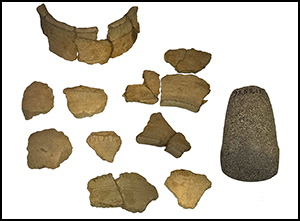Crossref Citations
This article has been cited by the following publications. This list is generated based on data provided by
Crossref.
Piličiauskas, Gytis
Asheichyk, Vitali
Osipowicz, Grzegorz
Skipitytė, Raminta
Varul, Liivi
Kozakaitė, Justina
Kryvaltsevich, Mikоla
Vaitovich, Aliaksandra
Lakiza, Vadzim
Šapolaitė, Justina
Ežerinskis, Žilvinas
Pamazanau, Mikalai
Lucquin, Alexandre
Craig, Oliver E.
and
Robson, Harry K.
2018.
The Corded Ware culture in the Eastern Baltic: New evidence on chronology, diet, beaker, bone and flint tool function.
Journal of Archaeological Science: Reports,
Vol. 21,
Issue. ,
p.
538.
Vanhanen, Santeri
Gustafsson, Stefan
Ranheden, Håkan
Björck, Niclas
Kemell, Marianna
and
Heyd, Volker
2019.
Maritime Hunter-Gatherers Adopt Cultivation at the Farming Extreme of Northern Europe 5000 Years Ago.
Scientific Reports,
Vol. 9,
Issue. 1,
Mannermaa, Kristiina
and
Kirkinen, Tuija
2020.
Tracing the Materiality of Feathers in Stone Age North-Eastern Europe.
Current Swedish Archaeology,
p.
23.
Pääkkönen, Mirva
Holmqvist, Elisabeth
Bläuer, Auli
Evershed, Richard P.
and
Asplund, Henrik
2020.
Diverse Economic Patterns in the North Baltic Sea Region in the Late Neolithic and Early Metal Periods.
European Journal of Archaeology,
Vol. 23,
Issue. 1,
p.
4.
Ahola, Marja
2020.
Creating a Sense of Belonging: Religion and Migration in the Context of the 3rdMillennium BC Corded Ware Complex in the Eastern and Northern Baltic Sea Region.
Norwegian Archaeological Review,
Vol. 53,
Issue. 2,
p.
114.
Alenius, Teija
Marquer, Laurent
Molinari, Chiara
Heikkilä, Maija
and
Ojala, Antti
2021.
The environment they lived in: anthropogenic changes in local and regional vegetation composition in eastern Fennoscandia during the Neolithic.
Vegetation History and Archaeobotany,
Vol. 30,
Issue. 4,
p.
489.
Soisalo, Janne
and
Roiha, Johanna
2022.
Kiukainen Culture Site Locations—Reflections from the Coastal Lifestyle at the End of the Stone Age.
Land,
Vol. 11,
Issue. 9,
p.
1606.
Bläuer, Auli
Solala, Hilja
Kinnunen, Jussi
and
Rannamäe, Eve
2022.
Multidisciplinary History of Goats in Finland: A Comparative Approach.
Heritage,
Vol. 5,
Issue. 3,
p.
1947.
Kirkinen, Tuija
López-Costas, Olalla
Martínez Cortizas, Antonio
Sihvo, Sanna P.
Ruhanen, Hanna
Käkelä, Reijo
Nyman, Jan-Erik
Mikkola, Esa
Rantanen, Janne
Hertell, Esa
Ahola, Marja
Roiha, Johanna
Mannermaa, Kristiina
and
Biehl, Peter F.
2022.
Preservation of microscopic fur, feather, and bast fibers in the Mesolithic ochre grave of Majoonsuo, Eastern Finland.
PLOS ONE,
Vol. 17,
Issue. 9,
p.
e0274849.
Kirkinen, Tuija
Wright, Krista
Suomela, Jenni
and
Ilves, Kristin
2023.
Microscopic fibres in soils – The accumulation of textile fibres and animal hairs at the 6th–11th-century CE Kvarnbo Hall settlement site on the Åland Islands, Finland.
Journal of Archaeological Science: Reports,
Vol. 47,
Issue. ,
p.
103809.
Vanhanen, Santeri
Kriiska, Aivar
and
Nordqvist, Kerkko
2023.
Corded Ware Culture Plant Gathering at the Narva-Jõesuu IIB Settlement and Burial Site in Estonia.
Environmental Archaeology,
p.
1.
Oras, Ester
Tõrv, Mari
Johanson, Kristiina
Rannamäe, Eve
Poska, Anneli
Lõugas, Lembi
Lucquin, Alexandre
Lundy, Jasmine
Brown, Samantha
Chen, Shidong
Varul, Liivi
Haferberga, Vanda
Legzdiņa, Dardega
Zariņa, Gunita
Cramp, Lucy
Heyd, Volker
Reay, Michaela
Pospieszny, Łukasz
Robson, Harry K.
Nordqvist, Kerkko
Heron, Carl
Craig, Oliver E.
and
Kriiska, Aivar
2023.
Parallel worlds and mixed economies: multi-proxy analysis reveals complex subsistence systems at the dawn of early farming in the northeast Baltic.
Royal Society Open Science,
Vol. 10,
Issue. 10,
Lempiäinen-Avci, Mia
Pukkila, Jouko
Bläuer, Auli
Pääkkönen, Mirva
and
Asplund, Henrik
2025.
New evidence of late Neolithic and early Metal Period agriculture in Turku, southwest Finland.
Vegetation History and Archaeobotany,
Vol. 34,
Issue. 1,
p.
121.



